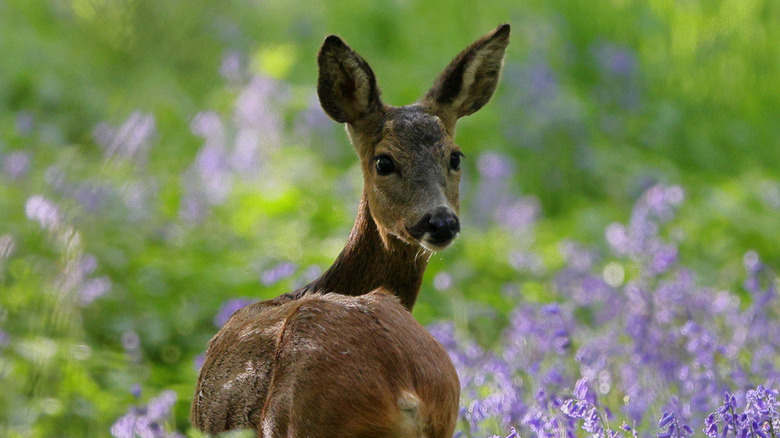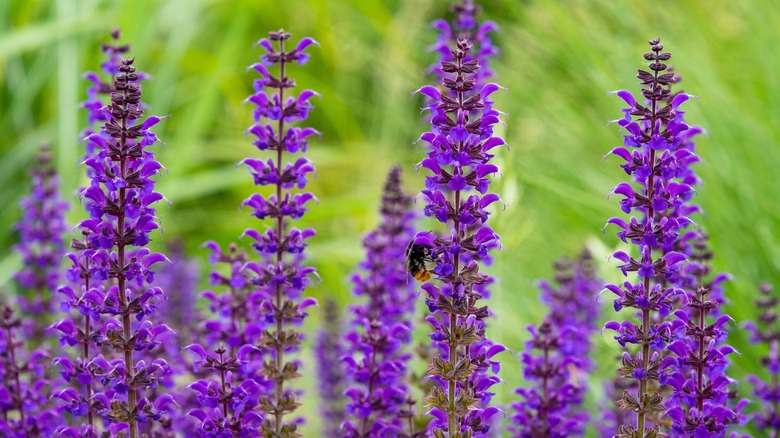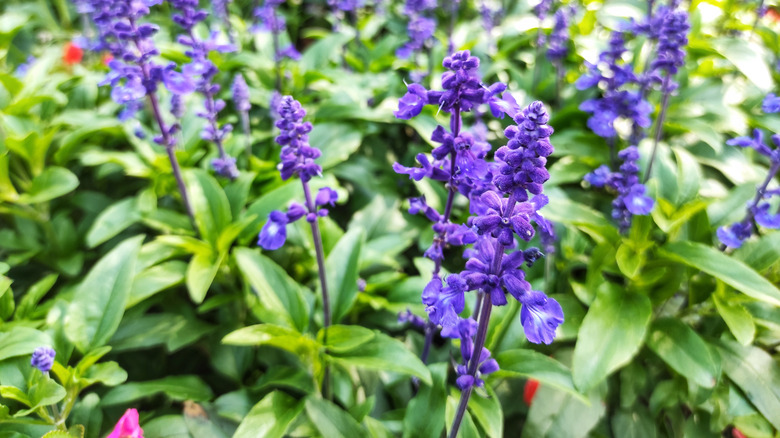The Beautiful Deer-Resistant Blue Flower That's Perfect For Your Pollinator Garden
As gardeners roll up their sleeves for all the fun in the sun that comes with warmer weather, the frustration it brings in the form of pests and diseases isn't far from their minds, either. While pollinators love to visit your garden to enjoy everything you've planted, deer love it just as much, since these seasons are usually when they need energy-rich foods the most. That's because spring and summer are usually when does are pregnant or nursing their young fawns, so they're very much on the prowl for nice things to nibble, and you need to consider some deer-resistant plants to save your garden from ruin.
Here's the trick: deer employ their strong sense of smell to find food sources. So, why not use that to beat them at their own game? Fragrant herbs have been known to repel deer and their aroma can be used to mask the smell of food. With that in mind, it's worth considering that black and blue salvia has been credited as a plant particularly unloved by deer, thanks to its pungent scent. And while defending your garden is reason enough to get digging, there are other reasons you'll enjoy these plants, as well.
The benefits of black and blue salvias
Black and blue salvias bring a dramatic and alluring contrast to your garden, where their bright blue flowers offer a charming pop of color. Their fragrant and nectar-rich buds also attract more pollinators to your garden, turning it into a buzzing oasis. That same fragrance is what puts deer off, though, because their strong scent receptors amplify the flowers' aroma and make it unbearable for them as they try to browse through your plants. Thus, when planted as a border around other plants and flowers in your pollinator garden, black and blue salvias will shield the rest of your garden from any deer that comes sniffing around.
Nothing's perfect, of course. Even though black and blue salvia is rarely browsed by deer, it's not impossible for deer to feel forced to nibble on them in the desperation of the moment, particularly when food sources are scarce. It's rare, though, and definitely not their preference.
Some more good news: with everything else you'll be doing for your garden this season, black and blue salvia is one less thing you'll have to pour sweat over. These perennials are fast-growing and low maintenance. Planted in the right conditions and given their fair share of care as young plants, these flowers grow to become stubbornly drought-tolerant once established. And they last, too — you can expect this tall shrub to offer delightful cobalt blooms until the first frosts of fall.
How to care for your black and blue salvias
Hardy in USDA Zones 7 through 10, black and blue salvia thrives in loamy, well-drained soil with good moisture. Too much moisture, however, puts this flower at risk of downy and powdery mildew, so you want to avoid waterlogging. This can be avoided by planting black and blue salvia in a spot where it will get full sun and very limited shade. Too much shade could cause the flowers' stems to become too long, while producing only a few blooms for the pollinators in your garden.
This requires you to think long and hard about the best layout for your garden, especially if deer prevention is the goal. Since you'll be planting these flowers as a border around other plants, consider pairing them with fragrant herbs or flowers to strengthen your garden's defenses against deer. Following that, keep these flowers looking their best by trimming them back to avoid longer stems from bending over. It's also a good idea to prune black and blue salvia to the ground in the fall, and you can use these cuttings to overwinter in a potted container near a sunny window. If you don't feel like doing that, though, you always have the option to leave the stems on the plants to winter on their own in colder climates.


